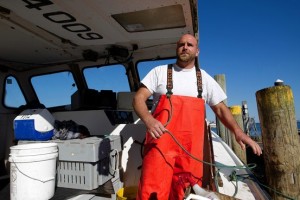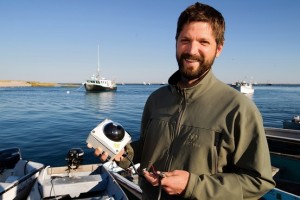redo Jump to...
print Print...

Commercial fisherman Nick Muto, securing his boat Monday in Chatham, Mass., says onboard monitors are ‘out there to kind of shut us down.’ (photo Matthew Healey for The Wall Street Journal)
(by Jennifer Levitz, The Wall Street Journal) CHATHAM, Mass. – When the 45-foot vessel the Lori B departs here for windy, 30-hour monk-fishing voyages, Nick Muto knows he will be sharing cramped quarters with his crew, the haul and often an unwelcome guest: a federally mandated observer who makes sure legal catch limits aren’t exceeded.
As the oversight program has grown…with the government’s use of quotas to prevent overfishing, so has friction between fleets and observers, from Cape Cod to Alaska. That has led to a push by crews and their advocates to replace human observers with cameras, an option regulators are exploring.
“We don’t want them on the boat. We feel as though they’re out there to kind of shut us down,” said Mr. Muto, a burly crew captain and the chairman of the Cape Cod Commercial Fishermen’s Alliance. Saying cameras would be more reliable and cause less tension, he described seasick observers who stayed in their bunks and others who “don’t give us any respect that we know what we’re doing.”
Observers, often young biology graduates who work for private companies that contract with the National Oceanic and Atmospheric Administration (NOAA), say they are well trained and necessary for thwarting illegal overfishing. They earn between $13 and $17 an hour in a job with high turnover.
“It’s almost like hazing; they’re going to make your life as hard as possible,” 28-year-old Christopher Stump said of the crews he worked with off Gloucester, Mass. The Arizona native entered the field after attending a marine-technician program in Hawaii, where he works as an observer after a stint in the Northeast.
Mr. Stump said New England crews would try to hide from him the morning of departure so he couldn’t make the trip, taunt him for being slow or in the way, and tell him he was ruining their trade.
The unease speaks to a larger challenge: balancing the fishermen’s livelihoods with the federal goal of rebuilding depleted fishing stocks and sustaining healthier ones. On-site regulators can cause clashes in many industries, but fishermen and fishing officials say the observer program is particularly challenging because the monitors essentially live on boats.
A 2006 federal law for the first time mandated enforceable annual catch limits to replenish depleted seas. It took several years for quotas to roll out, and 2012 was the first year that all federal fisheries—which contain species caught for commercial purposes—operated under them. Supporters say the plan is working, with U.S. commercial fishermen landing nearly 10 billion pounds of seafood in 2011, the most since 1994.
Enforcing yearly limits and setting new quotas has increased the need for data from vessels, said NOAA official Chris Rilling, recent head of the agency’s national observer program. …
Observers can’t stop crews from illegal fishing but note violations in log books, which are delivered to the NOAA. At sea, observers monitor what the fishermen catch as well as the undersized fish, usually dead, that are caught in the net and tossed back. The weight of the discards is subtracted from a fisherman’s quota. They also make sure endangered species, such as sea turtles, are properly released.

Tom Dempsey holds a camera being tested as a replacement for onboard human observers. (photo: Matthew Healey for The Wall Street Journal)
In Alaska, where this year certain small boats were required for the first time to carry observers, fisherman Dustan Dickerson told regulators at a public meeting that his wife didn’t like him fishing with female observers. “When you’ve got some 22-year-old [young woman] on the boat, it’s awkward,” the 52-year-old said in an interview. He said he would prefer cameras.
… In May, the Public Employees for Environmental Responsibility, an advocacy group, and the Association for Professional Observers, reported an uptick in harassment of observers, particularly in the Northeast, where tensions are high. Because cod and flounder stocks there haven’t rebounded as much as regulators hoped, limits for the fishing season that began in May are the lowest in decades. Between 20% and 30% of trips in the Northeast are being watched.
The NOAA and contractors say there are serious problems on only a small percentage of trips, but they acknowledge that observers face tense situations: New England regulators warned fishermen in an open letter in May not to take their frustrations out on observers.
The fishing industry pushback is having an effect. The NOAA said there will always be a need for human observers in some capacity. But the agency is testing cameras pointed at the where catch is handled, in pilot programs and working to improve the technology, Mr. Rilling said, adding the most likely use would be on smaller boats. On-deck sensors trigger the cameras, and the video is reviewed by fishery officials.
Cameras may be cheaper than observers. The NOAA says an electronic monitoring system, including at least four cameras on a vessel, costs $4,000 to $6,000. In 2012, Congress appropriated $54.9 million for observers, while fishermen contributed another $19 million. The government is still fully paying for monitoring Northeast cod fleets, but plans to shift the cost to the industry. …
Copyright 2013 Dow Jones & Company, Inc. All Rights Reserved. Reprinted here for educational purposes only. Visit the website at wsj.com.
Questions
1. a) Define mandate.
b) What mandate did a 2006 federal law establish?
2. How does the federal government enforce the 2006 law?
3. How do commercial fishermen regard the observers?
4. What alternative do commercial fishermen suggest in place of observers?
5. How has the government responded to the solution offered by commercial fishermen?
6. a) Is the government’s practice of observers being physically present the best way to make sure the law is enforced? Explain your answer.
b) Suggest at least one alternative that was not mentioned in the article.
7. Is this a necessary law or government intrusion? Explain your answer.
8. Discuss the following questions:
- Should observers be surprised that the fishermen object to being observed?
- Should commercial fishermen be opposed to government regulation as a means to ensure that the waters are not over-fished and the stocks depleted?
- If you had a government monitor watching you as you did your job to ensure your honesty, how would you react?
- If commercial fishermen should be monitored to ensure compliance with the law, should other industries be monitored this closely as well? (Should the government hire observers to monitor every industry in the U.S. as these individuals go about their jobs? teachers? law enforcement? doctors? accountants? lawyers? engineers? chefs? construction workers? home health care aids, day care workers, etc.) What criteria are necessary to determine which industries have full-time observers?
- The last paragraph of the article: “In 2012, Congress appropriated $54.9 million for observers, while fishermen contributed another $19 million. The government is still fully paying for monitoring Northeast cod fleets, but plans to shift the cost to the industry.” Is it right for the government to force fishermen to accept observers, and then to pay their salaries as well?
- Should all industries that are monitored by the government have to foot the bill for the monitors?
- Questions the article doesn’t answer: How big a problem was overfishing? Is the problem too many fishermen (the more commercial boats, the more fish being caught, even if each only gets their quota)? Is there a limit to the number of commercial fishing licenses the government sells? Is the issue that most commercial fishermen are stupid and greedy, and therefore need to be regulated? Are the observers respectful of the fishermen, their livlihood, their way of life?
Background
The National Oceanic and Atmospheric Administration (NOAA) is a scientific agency within the United States Department of Commerce focused on the conditions of the oceans and the atmosphere.
NOAA’s budget was $875 million for 2013.
NOAA warns of dangerous weather, charts seas and skies, guides the use and protection of ocean and coastal resources, and conducts research to improve understanding and stewardship of the environment.
In addition to its civilian employees, NOAA research and operations are supported by 300 uniformed service members who make up the NOAA Commissioned Officer Corps.
Daily “Answers” emails are provided for Daily News Articles, Tuesday’s World Events and Friday’s News Quiz.



